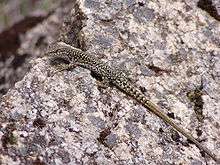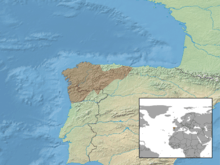Bocage's wall lizard
| Bocage's wall lizard | |
|---|---|
 | |
| Podarcis bocagei | |
| Scientific classification | |
| Kingdom: | Animalia |
| Phylum: | Chordata |
| Class: | Reptilia |
| Order: | Squamata |
| Family: | Lacertidae |
| Genus: | Podarcis |
| Species: | P. bocagei |
| Binomial name | |
| Podarcis bocagei (Seoane, 1885) | |
 | |
| Synonyms | |
| |
Bocage's wall lizard (Podarcis bocagei) is a species of lizard in the family Lacertidae. It is endemic to the Iberian Peninsula. The species' natural habitats are temperate forests, temperate shrubland, Mediterranean-type shrubby vegetation, sandy shores, rural gardens, and urban areas. The IUCN does not consider it to be threatened.
Etymology
Both the specific name, bocagei, and the common name, Bocage's wall lizard, are in honor of Portuguese zoologist José Vicente Barbosa du Bocage.[3]
Description
Bocage's wall lizard grows to a snout-to-vent length of about 7 cm (2.8 in) with a tail twice as long as this, males being larger than females. It is a sturdy lizard, somewhat flattened, and resembling Carbonell's wall lizard (Podarcis carbonelli). The dorsal surface is usually grey or yellowish-brown, but is sometimes green in males, copiously speckled with rows of dark markings. The flanks may be brownish or yellowish. The underparts are white, yellow, pink or orange but there are not any of the small blue spots along the edge of the belly often present in Carbonell's wall lizard.[4]
Distribution and habitat
Bocage's wall lizard is found in northern Portugal and northwestern Spain as far southwards as the River Douro. Its typical habitat is open deciduous woodland, scrubland, coastal sand dunes and cultivated areas, including in villages.[1]
Reproduction
This species is oviparous. Sexually mature females lay 2-4 clutches of eggs each year. Clutch size varies from 2 to 9 eggs.[1]
Status
Bocage's wall lizard is common in suitable habitat within its range. The population is steady and faces no specific threats and the International Union for Conservation of Nature has assessed its conservation status as being of "least concern".[1]
References
- 1 2 3 4 Sá-Sousa P, Pérez-Mellado V, Martínez-Solano I. 2005. Podarcis bocagei. 2006 IUCN Red List of Threatened Species. Archived June 27, 2014, at the Wayback Machine. Downloaded on 27 September 2014.
- ↑ The Reptile Database. www.reptile-database.org.
- ↑ Beolens B, Watkins M, Grayson M. 2011. The Eponym Dictionary of Reptiles. Baltimore: Johns Hopkins University Press. xiii + 296 pp. ISBN 978-1-4214-0135-5. (Podarcis bocagei, p. 28).
- ↑ Arnold, E. Nicholas; Ovenden, Denys W. (2002). Field Guide: Reptiles & Amphibians of Britain & Europe. Collins & Co. p. 152. ISBN 9780002199643.
![]() Media related to Podarcis bocagei at Wikimedia Commons
Media related to Podarcis bocagei at Wikimedia Commons
Further reading
- Arnold EN, Burton JA. 1978. A Field Guide to the Reptiles and Amphibians of Britain and Europe. London: Collins. 272 pp. ISBN 0-00-219318-3. (Podarcis bocagei, p. 143 + Plate 24 + Map 74).
- Engelmann W-E, Fritzsche J, Günther R, Obst FJ. 1993. Lurche und Kriechthiere Europas. Radebeul, Germany: Neumann Verlag. 440 pp. (including 324 color plates, 186 figures, 205 maps).
- Seoane VL. 1885. "Identidad de Lacerta schreiberi (Bedriaga) y Lacerta viridis, var. gadovii (Boulenger) é investigaciones herpetológicas de Galicia". La Coruña 1884: 1-19. (Lacerta muralis var. bocagei, pp. 18–19).
